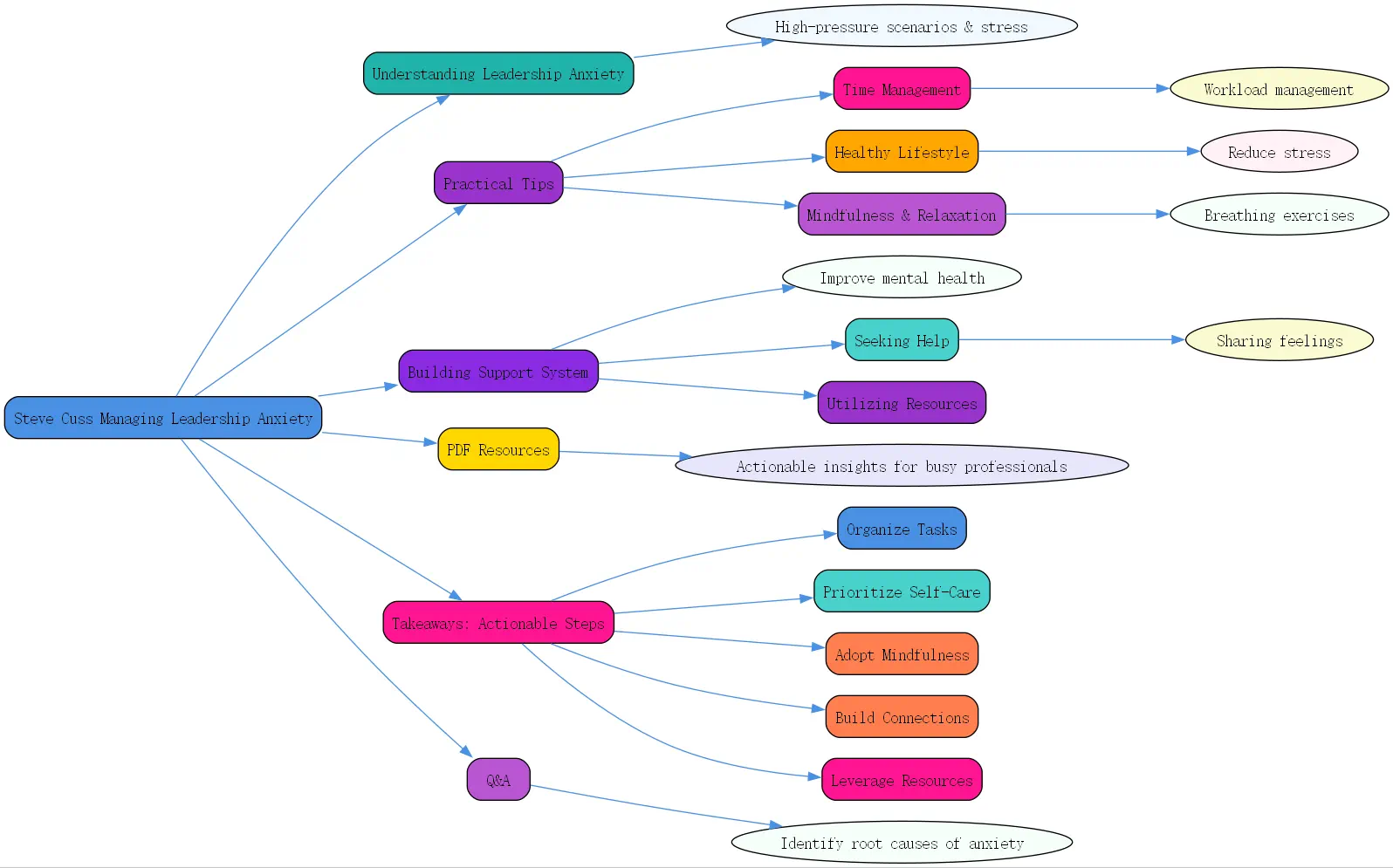Discover Steve Cuss’s insights on managing leadership anxiety. Learn actionable tips for stress management, healthy habits, mindfulness, and building supportive networks.
Steve Cuss Managing Leadership Anxiety: A Comprehensive Guide


Leadership is a rewarding yet demanding area of responsibility. Leaders often face high-pressure scenarios, requiring them to juggle complex decision-making, organizational challenges, and individual team dynamics閳ユ攣ll of which can trigger feelings of stress and anxiety. Steve Cuss, renowned for his expertise, emphasizes the importance of managing leadership anxiety effectively to foster impactful and sustainable leadership.
In this article, we’ll explore strategies inspired by Steve Cuss’s teachings, focusing on core concepts, practical tips, and actionable insights to help leaders reduce stress, improve clarity, and lead with confidence.
Understanding Leadership Anxiety
Leadership anxiety stems from the unique pressures that come with guiding a team or organization. Unlike general stress, anxiety in leadership roles can manifest due to high expectations, uncertainties, and the emotional toll of decision-making. Here’s what you need to know:
- The Unique Pressures of Leadership: From managing team dynamics to meeting organizational goals, leadership involves balancing multiple priorities. These pressures often lead to heightened anxiety, particularly when leaders feel isolated in their roles.
- Identifying Root Causes: Leadership anxiety may arise from fear of failure, perfectionistic tendencies, or the weight of accountability. Understanding the triggers behind your stress helps in developing targeted strategies to manage it.
- Why Addressing Anxiety is Critical: Leadership anxiety, if left unchecked, can impair decision-making, communication, and overall team morale. Leaders navigating anxiety effectively are better equipped to inspire and lead others.
Effective management begins with recognizing anxiety as a common challenge and adopting proven methods to combat its effects. Below, we delve into practical strategies for reducing stress in leadership roles.
Practical Tips to Manage Anxiety and Stress in Leadership
Time Management Strategies for Leaders
One of the most impactful steps leaders can take to address anxiety is mastering time management. Overwhelm from incomplete tasks and pressure to meet deadlines often amplifies stress. Strong planning skills can mitigate these challenges.
1. Prioritize Tasks and Delegate Effectively: Focus on high-impact activities and delegate secondary responsibilities to team members. A well-delegated workload reduces mental strain while empowering the team.
2. Utilize Planning Tools: Use digital planners, calendars, or project management tools like Trello or Asana to organize responsibilities across short- and long-term timelines. Breaking assignments into manageable steps increases productivity.
3. Set Realistic Goals: Avoid overcommitting by setting achievable deadlines. Break your day into blocks of leadership duties, team meetings, and short periods of downtime to remain organized.
Proactive time management not only enhances efficiency but also instills a sense of control閳ユ攣 key factor in reducing anxiety for leaders.
Promoting a Healthy Lifestyle to Reduce Stress
Steve Cuss highlights the crucial connection between mental wellness and lifestyle habits. As research shows, maintaining a healthy body supports emotional resilience and reduces stress. Leaders often neglect self-care, but prioritizing their health is vital.
1. Regular Exercise: Incorporate physical activity into your routine閳ユ敋hether it’s yoga, cycling, or jogging. Exercise boosts endorphin production, acting as a natural stress reliever.
2. Balanced Diet: A nutritious diet fuels the brain, stabilizing mood and enhancing focus. Avoid excessive caffeine or sugar consumption, as these can exacerbate anxiety.
3. Adequate Sleep: Sleep deprivation impairs cognitive function and increases emotional reactivity. Protecting your sleep by aiming for 7-9 hours per night ensures long-term focus and stability.
Healthy lifestyle choices not only enhance your physical well-being but also sharpen your capacity for clear thinking in leadership roles.
Mindfulness and Relaxation Techniques for Leaders

Mindfulness and relaxation have become essential tools for managing stress and anxiety. Steve Cuss recommends leaders embrace these practices to cultivate clarity and self-awareness in moments of pressure.
1. Practicing Mindfulness: Mindfulness involves focusing your attention on the present moment without judgment. Techniques like mindful meditation and body scanning can help leaders stay grounded amidst challenges.
2. Breathing Exercises: Techniques like box breathing or the 4-7-8 method are powerful tools for calming the nervous system during stressful situations. Practice these exercises daily or whenever reactive emotions rise.
3. Progressive Muscle Relaxation (PMR): PMR involves systematic tensing and relaxing of muscle groups, releasing physical stress. This approach works well before high-stakes meetings or presentations.
By cultivating mindfulness and relaxation techniques, leaders can reduce overwhelm and strengthen their emotional resilience.
Building a Strong Support System for Leaders
Even the most capable leaders benefit from having people they can turn to for support. Steve Cuss stresses that leaders seeking help and fostering connections improve not just their own mental health, but also their ability to lead effectively.
Seeking Help and Sharing Feelings
Leadership can be isolating, but sharing struggles with trusted individuals alleviates emotional burdens. Here’s why it matters:
- Talk Openly About Challenges: Confiding in mentors or peers removes stigmas around stress and anxiety. Honest discussions often lead to innovative solutions and enhanced collaboration.
- Develop Supportive Relationships: Building a network of allies閳ユ攩amily, friends, and professional connections閳ユ攽rovides leaders with encouragement during difficult times.
Utilizing Resources for Managing Leadership Anxiety
Modern leaders can leverage specialized resources to address anxiety. From counseling to workshops, these tools are tailored to improve mental health.
- Accessing Counseling: Professional therapists or coaches offer personalized guidance, helping leaders confront underlying stressors and develop healthy behaviors.
- Stress Management Workshops: Many organizations conduct workshops designed for leadership training. Resources such as these provide actionable strategies for overcoming workplace stress.
Leaders who embrace the support available to them unlock valuable insights, empowering them to thrive in challenging roles.
Steve Cuss Managing Leadership Anxiety PDF Resources
For leaders seeking structured knowledge, Steve Cuss offers extensive resources, including PDFs and guides. These materials give readers practical strategies to manage leadership anxiety.
- Where to Find Resources: PDFs addressing leadership struggles by Steve Cuss can be accessed through his official website or reputable platforms like BrainTalking. These resources are invaluable for leaders exploring sustainable solutions.
- Key Takeaways from Steve Cuss’s Teachings: Cuss emphasizes integrating time management, healthy habits, mindfulness, and community-building to combat anxiety effectively. The PDF guides distill his approach into actionable insights, suited for busy professionals.
Exploring Steve Cuss’s materials equips leaders with the knowledge needed to manage anxiety and lead confidently.
Takeaways: Actionable Steps for Leaders

Here are the steps to start managing leadership anxiety today:
- Organize Tasks: Use planners and delegation as tools for workload management.
- Prioritize Self-Care: Make time for regular exercise, balanced meals, and restorative sleep.
- Adopt Mindfulness and Relaxation: Practice breathing exercises and meditation during high-stress moments.
- Build Connections: Strengthen professional relationships and seek mental health support when needed.
- Leverage Resources: Explore Steve Cuss’s PDFs and workshops for further strategies.
Q&A Section: Addressing Leadership Anxiety
Q: What’s the first step for a leader to manage anxiety effectively? A: The first step is identifying the root causes of anxiety. Reflect on your triggers, such as fear of failure or workload overwhelm, and begin integrating proactive strategies like time management, mindfulness, and building supportive networks.




